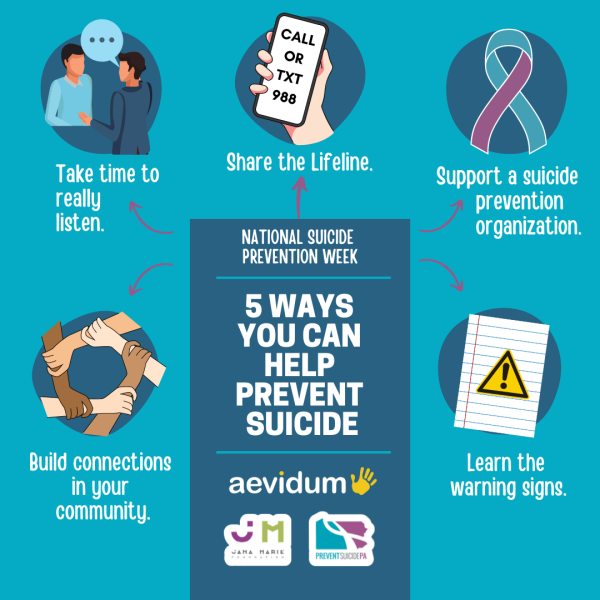Every day of every year, people all over the world struggle with the thoughts of taking their own lives. While September was set aside as Suicide Prevention Month, it’s important to keep this topic visible year-round so that those who struggle knowing how to cope or seeking the help that they need can find it long after all the teal and purple ribbons have all been tucked away.
In fact, statistics are showing that the number of people affected by suicide is rising globally each year. In August, the World Health Organization released these key facts:
- More than 720 000 people die due to suicide every year.
- Suicide is the third leading cause of death among 15–29-year-olds.
- Seventy-three per cent of global suicides occur in low- and middle-income countries.
- The reasons for suicide are multi-faceted, influenced by social, cultural, biological, psychological, and environmental factors present across the life-course.
- For every suicide there are many more people who attempt suicide. A prior suicide attempt is an important risk factor for suicide in the general population.
Clearly, mental health is an increasingly important issue within this topic. “The link between suicide and mental disorders (in particular, depression and alcohol use disorders) and a previous suicide attempt is well established in high-income countries,” the World Health Organization notes. “However, many suicides happen impulsively in moments of crisis with a breakdown in the ability to deal with life stresses, such as financial problems, relationship disputes, or chronic pain and illness.”
Developing positive coping skills is a move in the right direction. However, these skills appear to be at an all-time low and have been replaced by a host of negative alternatives. According to PositivePsychology.com, “Unhealthy coping mechanisms involve behaviors that provide short-term relief but may exacerbate distress in the long run. Substance abuse, avoidance, self-harm, and negative self-talk are among the most common examples of unhelpful coping strategies.” The website goes on to list these as the top ten negative coping strategies:
- Substance abuse
- Avoidance and denial
- Self-harm
- Negative self-talk
- Emotional eating or binge eating
- Isolation
- Procrastination
- Overworking
- Aggression
- Excessive screen time
 Do students here at Elkhart High School know what to do if they know of someone who is exhibiting any of these behaviors? Victoria Galan, a sophomore at EHS, is concerned that most don’t. “If I were thinking those thoughts, I would like to have support from my friends and family. And, I do have teachers at school I could talk to.” But, she notes, not all have that type of support system.
Do students here at Elkhart High School know what to do if they know of someone who is exhibiting any of these behaviors? Victoria Galan, a sophomore at EHS, is concerned that most don’t. “If I were thinking those thoughts, I would like to have support from my friends and family. And, I do have teachers at school I could talk to.” But, she notes, not all have that type of support system.
In fact, every year, millions suffer in silence with depression. The National Center for Health Statistics lists 49,476 suicide fatalities in 2022, making it the 11th leading cause of death in the nation. Firearm, suffocation, and poisoning top the list of methods.
 The evidence also suggests that “coping” comes in many forms. If students are having suicidal thoughts, it’s important that they know different ways to cope. “If I were to have suicidal thoughts, some ways a person could help me is by giving me coping mechanisms–things like cutting up paper, keeping it in a jar, and then when the jar gets full, either throw it away or set it on fire outside,” says Ryleigh Lovely, a sophomore.
The evidence also suggests that “coping” comes in many forms. If students are having suicidal thoughts, it’s important that they know different ways to cope. “If I were to have suicidal thoughts, some ways a person could help me is by giving me coping mechanisms–things like cutting up paper, keeping it in a jar, and then when the jar gets full, either throw it away or set it on fire outside,” says Ryleigh Lovely, a sophomore.
But, what are some of the other ways one could cope? “Music is very helpful for me,” Lovely adds. “Whenever I’m feeling down or depressed, I turn on my favorite artist and relax.” Still, there are other ways to manage. Actions such as taking a long walk, writing down one’s feelings, or simply talking to someone are sometimes enough. However, there are far more strategies one can utilize.
“The good news is that healthy coping is a skill that we can learn,” reassures PositivePsychology.com “We do not have to remain slaves to our less-than-helpful habits. We can begin the journey of practicing sustainable and generative ways of reacting to our challenges today.” The site lists six strategic areas to explore:
- Relaxation – Physical, mental, emotional, existential, and spiritual
- Affirmative Coping Statements– Mental, physical, emotional
- Positive Self-talk – Mental, emotional, self-esteem
- Community Support – Interpersonal, behavioral, emotional
- Attitude and Outlook – Emotional, mental, existential, spiritual
- Religious Practices – Emotional, existential, spiritual
The point is this: If a person is ever experiencing these feelings or thoughts, go seek help. Contacting the social workers and counselors right here at school is an excellent place to start. “If a student is experiencing suicidal thoughts/ideation,” stresses Mrs. Jami Presswood, EHS social worker, “please TALK to an adult! EHS is fortunate to have several school counselors and three school social workers who can help students struggling with suicidal thoughts. ”
Continuing, Presswood asserts, “These are not the types of conversations that should stay ‘secret’ between friends! It is crucial that you share with an adult or come see one of the school social workers, so we can talk with the student who is struggling. If you have concerns, whether about yourself or a friend, please reach out to one of the social workers.”
- Ms. Butler: [email protected]
- Mrs. Kidder: [email protected]
- Mrs. Presswood: [email protected]
But, if a person needs more immediate assistance–whether during school or not–he or she should not hesitate to call either of these two 24-hour emergency numbers:
- The Suicide and Crisis Lifeline: call or text 988
- The National Suicide Prevention Lifeline: 1-800-273-8255 (TALK)
September may be over, but life does not have to be. The issue needs to be addressed 365 days a year–starting today.





















E’vontez Young • Dec 16, 2024 at 2:48 pm
This was amazing. The title was eye catching, and the writer speaks about everyday problems we don’t talk about. Everyone suffers with mental health but not many people speak on it . Depression, anxiety, and feeling disassociated is a big problem in our community. Kids in our freshman building have problems expressing their feeling, so they bottle them up in till they explode and make impulsive decisions. But my over all question is what is the chemical balance in our teen minds that make us feel this way?
Ps. My dream job is an Mental health aid